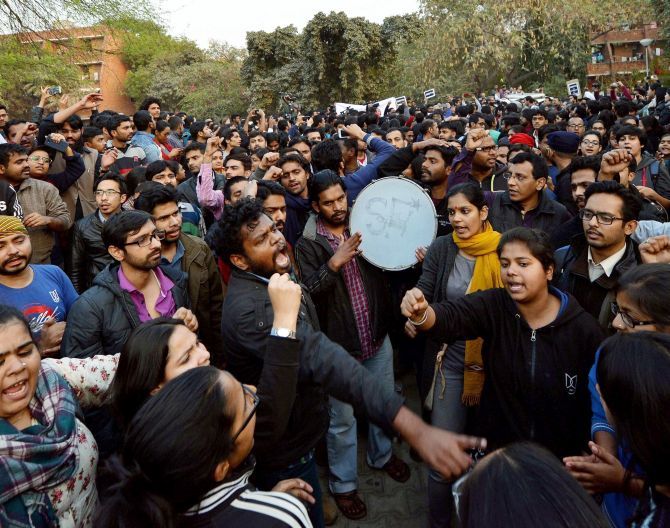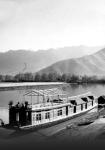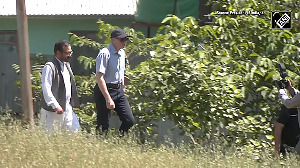
The State is trying to curb the students movements, therefore, there are suspicions against some of the Subramanian report on education's recommendations, says Mohammad Sajjad.
The Committee for the Evolution of a National Education Policy, headed by former Cabinet secretary T S R Subramanian, submitted its report to the Union human resources development ministry May 27.
Even though the 200-page report is yet to be made public, reactions from certain quarters on certain aspects of the report have started appearing in the media.
Its segment of student politics has attracted some attention. At least two student activists of Jawaharlal Nehru University, (Shehla Rashid, in The Indian Express, and an alumnus, Kavita Krishnan, on Scroll.in), have reacted on this segment of the Subramanian report said to be making some recommendations towards curbing student activism.
While the report seems to have kept itself oblivious of some of the best examples of healthy practices of student activism on certain campuses of our country, these well-meaning critics of the report also appear to be shying away from reflecting upon huge degenerations which have set in the students' (and teachers') politics across campuses.
However, what is even more objectionable about this report is the composition of the members of the Subramanian committee. The learned members don't seem to have been known as practitioners of healthy student activism.
Conversely put, the better known student activists turned academics have been kept out of the committee membership. In terms of ideological affiliations/leanings too, the composition of the committee does not seem to be an all inclusive one.
This was true even for the Lyngdoh Committee Report (2006) which had exclusive terms of reference to frame guidelines on the students' unions on university campuses.
The Lyngdoh report was, however, sensitive about taking note of campuses such as JNU which essentially has/had worth appreciating student politics. Presumably, this was unlike the Subramanian report which reportedly does not write appreciably about the healthy aspects of student activism, for instance on campuses like JNU and the University of Hyderabad.
Why cannot we ban student politics altogether?
A students union is both an associational and institutional interest group, essentially like trade unions. All liberal democracies have such organised groups to represent the collective interests of concerned groups of citizens, in this case, students.
Since democracy is a system of government by discussion, persuasion, accommodation and consensus, hence, such pressure groups like students unions have to be relatively radical in emancipatory ideas and mobilisation.
They have to organise gheraos, dharnas, and public demonstrations in protest against policies and actions that are antithetical to the larger collective interests of the student community and unemployed youth. They have to play important roles in national reconstruction.
They have to build enlightened public opinion, by promoting consensus, by enlisting sympathy, support and participation by a cross-section of opinion leaders in society and appealing to human reason, good sense and compassion. They have to influence the decision making.
The State and its organs like the university (administration) along with the students union have to encourage flow of ideas, promote public debate and discussion, and ensure students' participation in policy formulation and in running the affairs of the university.
The students union has also to provide meaningful information, critical perspectives and theoretical reflection on various issues. It has to analyse the socio-economic problems that we confront at various levels.
In short, since a students union does not have executive power, therefore, to ensure the protection of collective interests of the student community, it has to employ pressure tactics through democratic mobilisation.
A student leader, rather than becoming a self-serving, opportunist political operator, should not only be enlightened, informed, visionary, and sensitive but s/he should also be equipped with the art of mobilisation and negotiation.
Thus, the student movements are a unique part of the culture of higher education. One of the fundamental elements of the university community, the students' union has a genuine stake or vested interest in the operations of the university and the impact higher education can have on the world outside the walls of the academy.
The students who attended the first International Congress of Students in Latin America in 1909 had a direct impact on the University of Cordoba in 1918 and, ultimately, on the very structure of Latin American higher education.
In the United States, students drew the attention of their nation and that of the world to the futility of American involvement in a foreign conflict and forced their own universities to account for their business practices.
The Indian scenario
Although potentially compromised by the true leaders of the Independence movement, Indian students were a key component to their country's independence from British rule in 1947, and went on to represent a microcosm of a world embroiled in the Cold War.
Students, including educated unemployed youth, have become an important demand group in post-Independence Indian politics. Students have been in the vanguard of regime change. Yet, the students' political participation and mobilisation in India is often referred to as 'unrest', 'indiscipline' (in the official parlance of Aligarh Muslim University, India's largest residential university, it is invariably identified as 'anti-social activities').
The students are not treated as citizens having group interests, hence they are not supposed to be political actors. These are, needless to say, cultural constructs.
Agitational politics and mobilisation give the appearance of revolutionary potential. At residential universities (JNU, AMU, Banaras Hindu University, UoH, etc.), relatively unfettered conditions (in the hostels) lead them to search for personal identity and social meanings in ideologies and issues.
From the 1960s onwards, migration of rural students in urban colleges, combined with the spectre of unemployment, tended to drive them to agitation, as they became conscious and were able to get organised (even Aligarh's MAO College had 54 percent of its students from rural areas till 1900 AD, informs David Lelyveld).
The University of Hyderabad is one of our best universities. It also has an intellectually sharp and articulate, hence politically organised and assertive, Dalit student movement. Thus, representing the upward mobility of the historically most oppressed social groups who are articulating their grievances and urge for empowerment, and thereby strengthening our democracy.
Senior student leaders/alumni provide the personnel and political resources (at times for partisan and factional politics too). In most cases, easy access to political careers and the benefits of power have led students to act as tools and pawns in the hands of self-serving politicians and also aligning with reactionary political formations.
It dissipated their potential and capacities to challenge the rot afflicting the established political system.
Between 1965 and 1975, parts of India witnessed strong student movements -- the Navnirman Andolan in Gujarat and the Sampurna Kranti (Total Revolution or Jayaprakash movement) in Bihar -- against rampant corruption in the government and universities.
These movements, in many ways, were also the manifestation of organised assertions of new rural elites, the backward castes, who had made their ways in higher education, but consummate employment opportunities were yet to be offered.
Around this time, a section of students of premier institutions like St Stephen's College in Delhi and Presidency College in Calcutta ventilated their anger against rural discontent and the State's wilful failures in implementing land reforms. Some students joined the extremist Naxalite movement.
Strong administrative measures have often succeeded in crushing student agitations. The threat of repression and intimidation worked wonders for the moment, and pliant, committed, prejudiced vice-chancellors and their sycophant aides and advisors took charge.
These elements, say Lloyd I Rudolph and Susanne H Rudolph (In Pursuit of Laxmi, 1987), failed to realise that student agitations cannot be dealt with merely as a law and order problem.
Hence, rather than repression, persuasion and conceding the legitimate demands should be the preferred ways of dealing with student agitations. Most often, only real grievances and discontentment influence students to mobilise.
Misguided, self-serving student activism and deep rot in academics
As an insider, I have seen to my horror that even the tallest and most renowned academics have wilfully indulged in brazen practices like manipulating the system and extracting unscrupulous favours for their miserably unworthy cronies.
In one instance, an absolute non-academic, infamous as a rotten fixer on the campus, was one morning found to have been upgraded into an academic without any evaluation, and subsequently a research paper was also published in his name, understandably through ghost writing, in a Left-leaning, high rated academic journal, thereby grievously hurting the journal's credibility.
On this campus, the student leaders of the 1990s operated as admission mafias, infamous for carrying out violence, intimidation. They have now become rich property dealers with easy access to powerful politicians and legislators.
Today, such 'worthies' are into various bodies managing academic governance, hence have easy access to, and influence the highest functionaries of universities. By virtue of such power and influences they can extract most unscrupulous favours in admissions and faculty recruitments/promotions.
These disconcerting aspects of academia remain woefully under studied. The rotten politics within the temples of knowledge remain under-explored and under-exposed. The higher bureaucracy writes self-critical accounts, Bollywood makes movies exposing dirty practices prevalent within the industry, but the darker aspects of the politics of knowledge remain a closely guarded and unarticulated secret.
Among the rare exceptions could be the study of geographer Craig Jeffrey (now at Oxford University), whose study (2009) of the student-fixers on the Meerut University campus attempted to expose the rot within academia.
During the 1970s and 1980s, the hostels of some universities were hideouts for criminals wielding illegal arms and crude bombs. In Muzaffarpur, the hostels had become sites of shootouts and killings emerging out of intra-upper caste gang rivalries. Such a dispute once resulted in the killing of a principal of a premier college in Chapra.
A very ordinary chronicle, hence academically least noticed, P N Gour's study (1984) of the student unrest at the University of Bihar during 1967 an 1972, and some of the news reports of the 1980s, testify how some universities were turned into fiefdoms of various upper castes.
The colleges were opened by upper caste landlord-politicians who recruited their own caste-men, then these colleges were taken over by the government.
This arrangement provided upper caste elites practically with almost cent percent reservation in recruitments. This very social class already obtained medical and engineering degrees through capitation fees at private educational institutions.
Yet, this very social class, conveniently forgetting all these instances of gross casualties of merit, invoked the arguments of meritocracy while vehemently opposing the implementation of the Mandal Commission in the 1990s providing reservation of 27 per cent for the backward castes in public employment.
Similarly, in the name of gender justice, we insiders can see how the pettiest possible dirty politics of score-settling and nasty jealousies and bickerings of professionally deficient and under-accomplished academics are prevalent even on the best of our campuses.
One can go on multiplying such instances, but the rot within academia remains pitifully under-explored and therefore unarticulated.
The students and youth movements as well as the teachers associations shy away from articulating their own deeply entrenched follies. We hardly have comprehensive histories of even the oldest surviving, and influential students organisations such as the All India Students Federation and the Samajwadi Yuvajan Sabha.
The State, under neo-liberal economic dictates, is trying to curb the students and youth movements (as also the workers and peasants movements), and therefore obvious alarming suspicions against some of the Subramanian report's recommendations from sections of stake-holders.
For long, academicians have spoken from the high moral pedestal sitting in judgement against bureaucrats and politicians. In recent times, some media houses, subservient to rapidly triumphant crony capitalism, have also become outrageously slavish.
In such a scenario the onus on academics has increased manifold. They need to become self-critical, in order to become self-corrective.
The need of the hour is: While fighting these out, the other stake-holders in academics must also look at the rot within and must reflect self-critically.
Otherwise, we will be face to face with a huge disconnect between the common masses and the campuses.
In such a scenario all resistance to an unjust order will become weaker, subverting and defeating the noble purposes of campus politics we claim to champion.
Mohammad Sajjad teaches history at Aligarh Muslim University and has published Muslim Politics in Bihar: Changing Contours< (Routledge, 2014) and Contesting Colonialism and Separatism: Muslims of Muzaffarpur (Primus, 2014).






